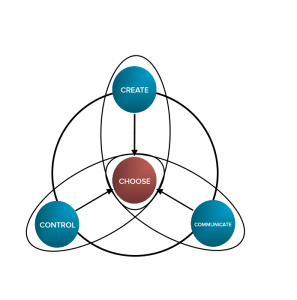
How does Do You See Clearly work?
Changes or projects are implemented in many different ways. So there are many methods and approaches such as Prince, PMBOK, Agile, Scrum, Lean, Sourcing, Life cycle Management, Reorganizations, etc. All these approaches have a number of fixed basic patterns.
If you want to know more about the background of the basic patterns, read on here.
Starting from our model with basic patterns, we build a sight glass to gain insight into the state of our project or program. The 4 components lead to 4 core questions.
The 4 core questions
- Is it true what we think?
- Does it live with those we want to move?
- Is it executable what we want to control?
- Are we making the real choices what we want to decide?
These 4 core questions can be asked for each of the 4 components for each phase, because we have seen that each component has its own dynamics in going through the 5 phases.
DYSC Scores
Each scoring area asks for your view and score in red-yellow-green whether based on reasoning, feeling or actual event. Weighting and assessment comes later, it is first of all about the observation.
The real value of DYSC comes from the participation of as many directly or indirectly involved parties as possible. By filling in different roles and positions, we arrive at a consolidated and specified picture, which helps us to discover relevant anomalous observations, so that what we did not see ourselves, but may be relevant.
The score per area is shown in color and in a number value. The scores red-yellow-green have the number values 0-5-10. The final score color is determined by the calculated average per score area.
When presenting the results, a distinction can be made between
- Date of completion during the project’s life cycle
- Role of the fillers
- Organizational position of the applicants
Date
By having those involved complete a DYSC during the life course of a project, we see how the scores develop or change. What we were sure of before, may now have doubts, and where there was doubt, the doubt may now have been removed.
Here we see how the score has developed over time.
Role
Our view of projects is influenced by the role we play in or with a project. It always gives a certain view based on our background, experience and expertise of the role we hold. In DYSC, the following roles are distinguished that the participants can occupy:
- Investor (funder): Those who belong to the party making and approving the investment for the project.
- Business (demand): those who determine the requirements and wishes for the product and/or services that the project is to deliver.
- Architect (architect): those who conceive and design solutions.
- Suppliers (supply): Those who detail, build, and implement chosen solution.
- Programme/Project Managers (Program/Project Manager): Those who direct the execution of the project.
Here we see the difference in score that the different roller carriers have in our project.
Position
Another element that can influence our view of a project is the organizational position. As with role, background, experience and attitude from the position taken are factors that can influence our view.
The distinguished positions are:
- Senior Management: those at the top of the organization who bear ultimate responsibility for the entire company, who are involved in the current project.
- Middle Management: those who are responsible for parts or departments of the company, which are involved in the current project.
- Team leadership: those who direct teams in the execution of the business activities involved in the current project.
- Employees: all those who are working on the implementation, who are involved in the current project.
- Outsiders: all those who are not involved, but who have a view of the project regardless of their organizational position.
Here you can see the difference in scores depending on management level in the organization.
DYSC reports
But not only the scores provide information, we are also interested in why someone gives a certain score, what was the reason, what was the subject of concern.
That is why the reports generated by the DYSC portal not only show the scores, but also the specifications that the respondents have provided to supplement or substantiate their score.
The available reports are:
By means of these insightful simple reports, we form a joint, complete and specific insight, which makes joint evaluation possible and measures can be determined together.
This way you can get a better idea of what and where your project needs adjustment or adjustment.
Interested? Look at DYSC Application or contact us and request a demo.










